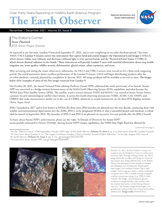The Earth Observer has a new look! Visit the NEW Earth Observer website.
The Earth Observer: Nov - Dec, 2021
In This Issue
Click title below to view page
- Feature Articles
- Getting Maximum IMPACT from Earth Science Data4
- NASA Participates in United Nations Climate Change Conference10
- Meeting Summaries
- Partnerships, Co-Production, and Transdisciplinary Science: The 2021 PACE Applications Workshop14
- Summary of the Seventh DSCOVR EPIC and NISTAR Science Team Meeting24
- In The News
- Global Climate Change Impact on Crops Expected Within 10 Years, NASA Study Finds32
- NASA, ESA Partnership Releases Platform for Open-Source Science in the Cloud34
- Instruments in the Sea and Sky: NASA’s S-MODE Mission Kicks Off First Deployment35
- Kudos
- Jack Kaye Receives 2021 Presidential Rank Award36
- Regular Features
- NASA Earth Science in the News37
- Earth Science Meeting and Workshop Calendar39
The Editor’s Corner
Steve Platnick
EOS Senior Project Scientist
As reported in our last issue, Landsat 9 launched September 27, 2021, and is now completing its on-orbit checkout period.1 The joint NASA–USGS Landsat 9 mission carries two instruments that capture land and coastal imagery: the Operational Land Imager 2 (OLI-2), which detects visible, near-infrared, and shortwave-infrared light in nine spectral bands; and the Thermal Infrared Sensor 2 (TIRS-2), which detects thermal radiation in two bands.2 These instruments will provide Landsat 9 users with essential information about crop health, irrigation use, water quality, wildfire severity, deforestation, glacial retreat, urban expansion, and more.
Read more...

